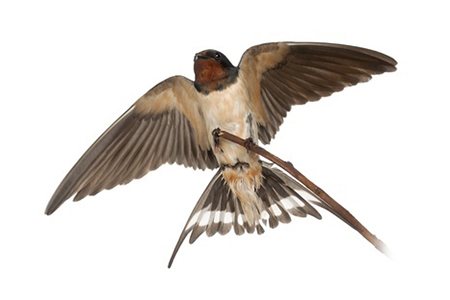
Swallows
Pestgon FactSheet
CLIFF SWALLOW: (Petrochelidon pyrrhonota)
Description:
Cliff swallows are birds about 5 to 6 inches in length that are constantly on the fly insearch of insects, when not sitting on the nest. They are recognized by their long pointed wings as they dart about the sky with great speed and maneuverability. Up close they are pale, orange-brown rump, white forehead, dark rust-colored throat, and steel blue crown back and wings. Normally, swallows are not seen on the ground except when collecting mud for their gourd-shaped nests. .
Biology:
Cliff Swallows were made famous by the romantic song, "When the Swallows Return to Capistrano" that refers to their habitual return to their migratory home every spring. Cliff Swallows feed on insects and spend a large part of time in the air catching flies, gnats, beetles, and mosquitoes. These swallows build mud nests attached to eves and overhangs of buildings and other structures; a habit that sometimes puts them into conflict with building owners and commercial property managers. This is particularly true when the Cliff Swallow decides to build a colony, where several nesting pairs build dozens of mud nests. The nests are cemented to underside of an overhang of buildings, bridges, or other vertical surfaces. Once they start, their habit is to form a dense cluster or colony of gourd-shaped mud nests.
Economic Impact:
A colony of Cliff Swallows nesting on a commercial building can become a big nuisance adding to the cost of maintenance and sanitation. Pestgon, Inc. has seen where mud nests and droppings have destroyed stucco and other surfaces, defacing the appearance of a building. Cliff swallows are colonial so the number of nesting birds will increase significantly from
year to year. Their copious droppings present a potential health hazard. Swallow nests contain mites and insects and swallow bugs (bed bugs) that can enter buildings. The decaying mud nests eventually fall to the ground and can cause injury, particularly if the nests are above a door or walkway. So while there may be something romantic about the swallows returning to Capistrano, when they have attached themselves to your commercial building, they are not just a nuisance but, an economic liability.
Management Methods:
Issues with swallows should be managed as soon as they appear and are identified. Pestgon, Inc. finds that they are best managed by nest removal and exclusion techniques. Their mud can be washed off or removed prior to nesting, but it is imperative to act quickly upon their arrival. Netting can provide an effective physical barrier between the birds and the nest site. Once the swallows have completed their nest, they immediatley lay their eggs and come under the protection of the Migratory Bird Treaty Act of 1918. Swallows are then protected by State and Federal regulations, as migratory birds. During nesting, a permit authorizing removal can only be issued by the, U.S. Fish and Wildlife Service, and only if it can be justified by strong, compelling reasons such as health or hazard. If the nests are disturbed or removed while under the protection of State and Federal Law, fines can be imposed of $25,000 and up!
Additional Links:
http://www.ipm.ucdavis.edu/PMG/PESTNOTES/pn7482.html
